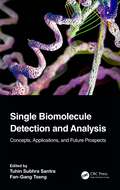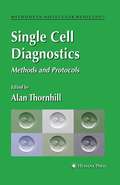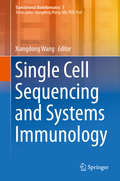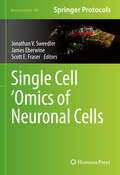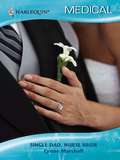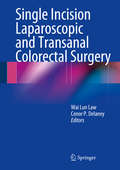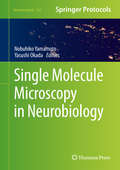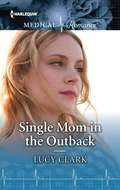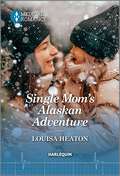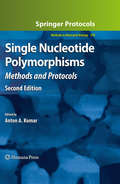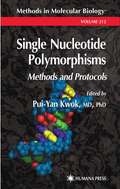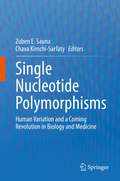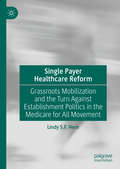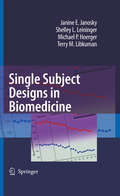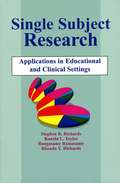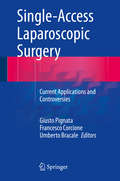- Table View
- List View
Single Biomolecule Detection and Analysis: Concepts, Applications, and Future Prospects
by Fan-Gang Tseng Tuhin Subhra SantraThis collection discusses various micro/nanodevice design and fabrication for single-biomolecules detection. It will be an ideal reference text for graduate students and professionals in diverse subject areas including materials science, biomedical engineering, chemical engineering, mechanical engineering, and nanoscience. This book- Discusses techniques of single-biomolecule detection, their advantages, limitations, and applications. Covers comprehensively several electrochemical detection techniques. Provides single-molecule separation, sensing, imaging, sequencing, and analysis in detail. Examines different types of cantilever-based biomolecule sensing, and its limitations. Single Biomolecule Detection and Analysis covers single-biomolecule detection and characterization using micro/nanotechnologies and micro/nanofluidic devices, electrical and magnetic detection technologies, microscopy and spectroscopy techniques, single biomolecule optical, and nanopore devices. The text covers key important biosensors-based detection, stochastic optical reconstruction microscopy-based detection, electrochemical detection, metabolic engineering of animal cells, single-molecule intracellular delivery and tracking, terahertz spectroscopy-based detection, total internal reflection fluorescence (TIFR) detection, and Fluorescence Correlation Spectroscopy (FCS) detection. The text will be useful for graduate students and professionals in diverse subject areas including materials science, biomedical engineering, chemical engineering, mechanical engineering, and nanoscience. Discussing chemical process, physical process, separation, sensing, imaging, sequencing, and analysis of single-molecule detection, this text will be useful for graduate students and professionals in diverse subject areas including materials science, biomedical engineering, chemical engineering, mechanical engineering, and nanoscience. It covers microscopy and spectroscopy techniques for single-biomolecule detection, analysis, and their biomedical engineering applications.
Single Cell Diagnostics
by Alan R. ThornhillThis book applies modern molecular diagnostic techniques to the analysis of single cells, small numbers of cells, or cell extracts. Emphasis is placed on non-invasive analysis of single cell metabolites and the direct analysis of RNA and DNA from single cells, with a focus on polymerase chain reaction and fluorescence in situ hybridization. In particular, this handbook is essential for practitioners providing care for couples seeking treatment for infertility.
Single Cell Sequencing and Systems Immunology
by Xiangdong WangThe volume focuses on the genomics, proteomics, metabolomics, and bioinformatics of a single cell, especially lymphocytes and on understanding the molecular mechanisms of systems immunology. Based on the author's personal experience, it provides revealing insights into the potential applications, significance, workflow, comparison, future perspectives and challenges of single-cell sequencing for identifying and developing disease-specific biomarkers in order to understand the biological function, activation and dysfunction of single cells and lymphocytes and to explore their functional roles and responses to therapies. It also provides detailed information on individual subgroups of lymphocytes, including cell characters, function, surface markers, receptor function, intracellular signals and pathways, production of inflammatory mediators, nuclear receptors and factors, omics, sequencing, disease-specific biomarkers, bioinformatics, networks and dynamic networks, their role in disease and future prospects. Dr. Xiangdong Wang is a Professor of Medicine, Director of Shanghai Institute of Clinical Bioinformatics, Director of Fudan University Center for Clinical Bioinformatics, Director of the Biomedical Research Center of Zhongshan Hospital, Deputy Director of Shanghai Respiratory Research Institute, Shanghai, China.
Single Cell ‘Omics of Neuronal Cells (Neuromethods #184)
by Jonathan V. Sweedler James Eberwine Scott E. FraserThis volume discusses the latest techniques used in the diverse fields of single cell ‘omics and covers topics such as quantifying the single cell transcriptome; isolation of cells in nanoliter volumes for single cell proteomics measurements by nano-LC-MS/MS; and single cell protein characterization by immunoblotting. A wide range of methodologies are highlighted, ranging from high-yield chemical amplification to mass spectrometry and nanotechnology for the analysis of the chemical constituents of cells. In the Neuromethods series style, chapters include both in-depth overviews, as well as detailed protocols that provide the key advice from specialists you need to get successful results in your laboratory. Cutting-edge and comprehensive, Single Cell ‘Omics of Neuronal Cells is a valuable resource for experienced and novice researchers interested in learning more about this field and its future developments.
Single Dad Seeks a Wife
by Melanie MilburneMaking the doctor his bridePenhally Bay is a world away from everythingDr. Eloise Hayden knows. But this forensic specialisthas come to Cornwall's coast to find justice.Gorgeous police inspector Lachlan D'Ancey partners with Eloise on the case and finds himself mesmerized by this stunning Australian. But he fears that his daughter will become embroiled in the investigation. He can't stand in the way of justice, but he's torn between his duty to his career, his duty to his only child and a newfound duty to the woman he's falling in love with.Eloise soon realizes that the single dad needs her help-together, they may be able to find an answer. Only then can Lachlan ask Eloise the most important question of all....
Single Dad in Her Stocking: Sleigh Ride With The Single Dad A Firefighter In Her Stocking A Christmas Miracle
by Alison RobertsThe greatest gift he could give her?A family…After losing her baby, and sacrificing her pediatric career, Emma spends every Christmas as an emergency locum—and this year she’ll be covering A&E consultant Max Cunningham. Their one kiss years ago was unforgettable, and now that this ex-playboy is daddy to three orphaned children, he’s dangerously tempting! But as Max welcomes Emma into his home, she soon wishes her family for Christmas could be forever…“I read this in one sitting. This was such a heart-felt story. I loved the characters. The author really did a fantastic job…. I highly recommend this story to anyone. It was a real treat to read.”—Goodreads on Pregnant with Her Best Friend’s Baby“This book is Alison Roberts at the top of her game: a deeply emotional romance…. I'm not particularly generous with five-stars for romances…the book has to be exceptional. I thought this one was.”—Goodreads on Resisting Her Rescue Doc
Single Dad's Fake Fiancée (Nashville Midwives)
by Deanne AndersAfter their plus-one wedding date goes down without a hitch, a midwife continues to fake date her single-dad doctor colleague. But soon their feelings are far too strong to be pretend… Read more in this final installment of Deanne Anders&’s Nashville Midwives trilogy! THE KEY TO HIS FAMILY REUNION? After Dr. Zachary Morales agrees to be midwife Lori Mason&’s plus-one to her best friend&’s wedding, she&’s determined to repay the widower. So when prolonging their &“relationship&” could help Zach regain custody of his beloved son, Lori doesn&’t think twice about pretending to be the future Mrs. Morales. Romance reader Lori has watched characters pull off the faux-fiancée trope before and is certain it will be a piece of cake! She just needs to be careful that her heart doesn&’t blur the lines between fact and fiction…From Harlequin Medical: Life and love in the world of modern medicine. Nashville MidwivesBook 1: Unbuttoning the Bachelor DocBook 2: The Rebel Doctor's Secret ChildBook 3: Single Dad's Fake Fiancée
Single Dad's Triple Trouble
by Fiona LoweDr Gabe Lewis is a single dad. . . to triplets! But Gabe's adorable tots are triple the trouble -- especially when it comes to simple things like babies' bath time. He knows someone who could help -- someone really special who has recently re-entered his life. But Gabe once broke Dr Elly Ruddock's heart. Can he perform another miracle by mending it again, with the help of his mischievous trio?
Single Dad, Nurse Bride
by Lynne MarshallWanted: mother for young twin girls!Dangerously handsome Dr. Dane Hendricks certainly isn't nurse Rikki Johansen's usual type. For one thing, she thinks he's arrogant and overbearing, and for another, he assumed she was scatterbrained and incapable of making good decisions. So why is he so adamant about taking her on a date? Rikki soon discovers that Dr. Dane is actually a kind an sensitive dad, and, like her, he's one of life's survivors. A foster mother herself, Rikki knows she can bring Dane's adorable twin girls--and their gorgeous dad--the happiness they deserve.
Single Dad, Nurse Bride
by Lynne MarshallDangerously handsome Dr. Dane Hendricks certainly isn't nurse Rikki Johansen's usual type. For one thing, she thinks he's arrogant and overbearing, and for another, he assumed she was scatterbrained and incapable of making good decisions. So why is he so adamant about taking her on a date? Rikki soon discovers that Dr. Dane is actually a kind and sensitive dad, and, like her, he's one of life's survivors. A foster mother herself, Rikki knows she can bring Dane's adorable twin girls--and their gorgeous dad--the happiness they deserve.
Single Dad, Outback Wife
by Amy AndrewsWanted: wife and motherDistinguished city surgeon Andrew Montgomery is the new doctor in a small town, and the new guardian to his young nephew, Cory. Out of his depth in his role as a single dad, he turns to beautiful nurse Georgina Lewis for help.Andrew is enchanted by Georgina--she is wonderful with Cory, devoted to her patients and absolutely perfect for Andrew. He never envisaged staying in the Australian Outback, but now he's not sure he wants his old life back. His future is here, in the town that has become his home... with the woman who has captured his heart.
Single Domain Antibodies
by Dirk Saerens Serge MuyldermansThe development of the hybridoma technology created the possibility to obtain unlimited amounts of monoclonal antibodies (mAb) with high specificity and affinity for any target and to introduce mAbs in a wide range of applications; however, the bulky size of mAbs, costly production, and cumbersome engineering hampered regularly their streamlined development in some applications. In Single Domain Antibodies: Methods and Protocols, expert researchers examine single variable domain antibody fragments, referred to as VH, VL, VHH or VNAR. These fragments are the smallest intact antigen-binding fragments that can be produced recombinantly at low cost. Written in the highly successful Methods in Molecular BiologyTM series format, chapters include introductions to their respective topics, lists of the necessary materials and reagents, step-by-step, readily reproducible laboratory protocols, and tips on troubleshooting and avoiding known pitfalls.
Single Incision Laparoscopic and Transanal Colorectal Surgery
by Wai Lun Law Conor P. DelaneySingle Incision Laparoscopic and Transanal Colorectal Surgery provide a comprehensive and state-of-the art review of single incision laparoscopic and transanal colorectal surgery. The text concentrates on surgical techniques and tricks in single incision laparoscopic and transanal surgery with detailed descriptions of the techniques, as well as indications and limitations of the procedures. The newly available evidence on these procedures is emphasized and all procedures are richly illustrated with diagrams and photos. Written by experts in their fields, Single Incision Laparoscopic and Transanal Colorectal Surgery is valuable resource for general surgeons, colon and rectal surgeons, laparoscopic GI surgeons, surgical residents and fellows in training interested in these two rapidly developing fields in colorectal surgery.
Single Molecule Microscopy in Neurobiology (Neuromethods #154)
by Nobuhiko Yamamoto Yasushi OkadaThis volume looks at the methodology and techniques used by experts to study how certain molecules function in specific locations, and their temporal patterns. Chapters in this book cover topics such as in vivo single-molecule tracking of voltage-gated calcium channels with split-fluorescent proteins in CRISPR-engineering C. elegans; protein-protein interactions in membranes using single particle tracking; neuropathological diseases revealed by quantum-dot single particle tracking; SPoD-OnSPAN; and investigating molecular diffusion inside small neuronal compartments with two-photon fluorescence correlation spectroscopy. In the Neuromethods series style, chapters include the kind of detail and key advice from the specialists needed to get successful results in your laboratory.Cutting-edge and comprehensive, Single Molecule Microscopy is a valuable resource for any researcher interested in learning more about this important field.
Single Molecule and Single Cell Sequencing (Advances in Experimental Medicine and Biology #1129)
by Yutaka SuzukiThis book presents an overview of the recent technologies in single molecule and single cell sequencing. These sequencing technologies are revolutionizing the way of the genomic studies and the understanding of complex biological systems. The PacBio sequencer has enabled extremely long-read sequencing and the MinION sequencer has made the sequencing possible in developing countries. New developments and technologies are constantly emerging, which will further expand sequencing applications. In parallel, single cell sequencing technologies are rapidly becoming a popular platform. This volume presents not only an updated overview of these technologies, but also of the related developments in bioinformatics. Without powerful bioinformatics software, where rapid progress is taking place, these new technologies will not realize their full potential. All the contributors to this volume have been involved in the development of these technologies and software and have also made significant progress on their applications. This book is intended to be of interest to a wide audience ranging from genome researchers to basic molecular biologists and clinicians.
Single Mom in the Outback: Their Own Little Miracle Single Mom In The Outback Bachelor Doc, Unexpected Dad
by Lucy ClarkSingle mom meets single dad…An unexpected chance for love?Dr. Bianca Treymane has always dreamed of living in Australia, so she jumps at the chance to work in an outback clinic. It’s the fresh start she and her son need after her cheating husband’s death. She just never expected her new boss, single dad Marshall Chessman, to be quite so sexy. Is their instant chemistry enough for them to take a chance on love?
Single Mom's Alaskan Adventure
by Louisa HeatonShe was hoping for a fresh start in scenic Alaska…but she&’s got history with her new boss! Find out more in Louisa Heaton&’s latest Harlequin Medical Romance. OLD FRIENDS. NEW BEGINNINGS? Determined to outrun a humiliating ordeal, single mom Dr. Charlie arrives in Alaska and is stunned to meet her boss—a blast from the past—delectable local doc, Eli. They clash at first, but Eli&’s infectious enthusiasm soon brings Charlie out of her shell…and, even though he&’s holding something back, their chemistry skyrockets! Charlie knows she has to stop running eventually, and a fresh start with Eli would certainly be a life-changing adventure…From Harlequin Medical: Life and love in the world of modern medicine.
Single Nucleotide Polymorphisms
by Anton A. KomarIn recent years, single nucleotide polymorphisms have received increased and special attention in a rapidly developing field of personalized medicine and drug treatment. Comprising more than eighty percent of all known polymorphisms, single nucleotide polymorphisms (SNPs) are primarily responsible for phenotypic differences between individuals, and have been suggested to affect the development of diseases in humans and the response to drug treatment and environmental stress. In Single Nucleotide Polymorphisms: Methods and Protocols, Second Edition, expert researchers explore the latest advances in this area, highlighting the substantial progress that has been made in SNP genotyping, examining recent developments in high-throughput genotyping approaches, and exploring our new understanding of the impact of SNPs on gene function. Chapters address the impact of SNPs on phenotype, examine SNP databases, look at methods that have been applied for SNP bioinformatics discovery and analysis, and discuss advanced experimental approaches used for SNP detection. Composed in the highly successful Methods in Molecular BiologyTM series format, each chapter contains a brief introduction, step-by-step methods, a list of necessary materials, and a Notes section which shares tips on troubleshooting and avoiding known pitfalls. Current and innovative, Single Nucleotide Polymorphisms: Methods and Protocols, Second Edition is an essential guidebook for individual researchers as well as institutions and companies working in the field.
Single Nucleotide Polymorphisms
by Pui-Yan KwokPui-Yan Kwok, MD, PhD, has assembled a comprehensive collection of readily reproducible techniques for the difficult process of single nucleotide polymorphisms (SNP) discovery and genotyping. These cutting-edge protocols for mutation/SNP detection utilize denaturing high-performance liquid chromatography (dHPLC), single-strand conformation polymorphism (SSCP), conformation-sensitive gel electrophoresis (CSGE), chemical cleavage, and direct sequencing. Equally powerful and up-to-date methods are given for genotyping SNPs, including molecular beacons, the Taqman assay, single-base extension approaches, pyrosequencing, ligation, the Invader assay, and primer extension with mass spectrometry detection.
Single Nucleotide Polymorphisms: Human Variation and a Coming Revolution in Biology and Medicine
by Chava Kimchi-Sarfaty Zubeen E. SaunaThis book explores the importance of Single Nucleotide Polymorphisms (SNPs) in biomedical research. As SNP technologies have evolved from labor intensive, expensive, time-consuming processes to relatively inexpensive methods, SNP discovery has exploded. In terms of human biology, this research, particularly since the completion of the Human Genome Project, has provided a detailed understanding of evolutionary forces that have generated SNPs. It also has shown how SNPs shape human variation. The ability to inexpensively generate and analyze vast amounts of genetic data is poised to transform our understanding of human evolution and biology. “Single Nucleotide Polymorphisms” covers a broad survey of SNPs and their classification into synonymous and non-synonymous; the role of SNPs in human disease; case studies providing specific examples of synonymous and non-synonymous SNPs associated with human diseases or affecting therapeutic interventions; mechanisms by which synonymous mutations affect protein levels or protein folding which affect human physiology and response to therapy; and the role of SNPs in personalized medicine. Understanding what SNPs are, how they have been shaped is necessary for an increasingly expanding audience. This research will revolutionize the future of medicine. Chapter 4 is available open access under a Creative Commons Attribution 4.0 International License via link.springer.com.
Single Payer Healthcare Reform: Grassroots Mobilization and the Turn Against Establishment Politics in the Medicare for All Movement
by Lindy S.F. HernThe recent rise of “Medicare for All” in American political discourse was many years in the making. Behind this rise is a movement composed of grassroots activists and organizations that have been working for more than three decades to achieve the goal of establishing a single-payer healthcare system in the United States. In the past decade, the Single Payer Movement has grown and garnered more public and political support than ever before. This relative success cannot be attributed to any one political figure or political era. The story of how this happened, and how it is tied to a turn against establishment politics on both the left and right, as well as the rise of outsider politicians such as Senator Bernie Sanders, takes place during the Clinton, G.W. Bush, Obama, and Trump administrations. During each of these eras, activists experienced shifting opportunities that they interpreted through the telling of stories. These narratives of opportunity encouraged participation in particular forms of grassroots mobilization, which then affected the outcome of each era. This has had lasting effects on the development of healthcare policy in the United States. In this book, Hern conducts a political ethnographic analysis in which she uses historical records, interviews, and participant observation to tell the story of the Single Payer Movement, establish the lessons that can be learned from this history, and develop a framework—the Environment of Opportunity Model—that involves a holistic understanding of social movement activity through the analysis of narrative practice.
Single Session Thinking and Practice in Global, Cultural, and Familial Contexts: Expanding Applications
by Michael F. HoytSingle Session Thinking and Practice teaches readers how to implement single session approaches by encouraging practitioners and clients to collaborate in making the most of every encounter. Single session/one-at-a-time approaches are applicable in a multitude of settings, including clinics, private offices, medical centers, and student counseling services – and can be used both in person and online. Leading international figures and those practicing on the front lines provide guidance for conducting SST in a variety of contexts. Chapters feature descriptions of theoretical underpinnings, pragmatic clinical examples, cross-cultural applications, research findings, service delivery models, and implementation tips. This text will be an instant and essential reference for anyone in the fields of brief therapy, casework, and healthcare, as well as walk-in and by-appointment single session services.
Single Subject Designs in Biomedicine
by Janine E. Janosky Michael P. Hoerger Shelley L. Leininger Terry M. LibkumanSingle Subject Designs in Biomedicine draws upon the rich history of single case research within the educational and behavioral research settings and extends the application to the field of biomedicine. Biomedical illustrations are used to demonstrate the processes of designing, implementing, and evaluating a single subject design. Strengths and limitations of various methodologies are presented, along with specific clinical areas of application in which these applications would be appropriate. Statistical and visual techniques for data analysis are also discussed. The breadth and depth of information provided is suitable for medical students in research oriented courses, primary care practitioners and medical specialists seeking to apply methods of evidence practice to improve patient care, and medical researchers who are expanding their methodological expertise to include single subject designs. Increasing awareness of the utility in the single subject design could enhance treatment approach and evaluation both in biomedical research and medical care settings.
Single Subject Research: Application in Educational and Clinical Settings
by Stephen B. Richards Ronald Taylor Rangasamy Ramasamy Rhonda Y. RichardsThis practical, user-friendly textbook provides background knowledge, basic concepts, and understanding of relevant issues related to applied behavior analysis and specifically to single subject research designs.
Single-Access Laparoscopic Surgery
by Giusto Pignata Francesco Corcione Umberto BracaleSingle-access laparoscopic surgery (SALS), performed using a single transumbilical access, has recently proved to bring advantages over other forms of laparoscopic surgery due to the reduction in the number of incisions and the consequent decrease in morbidity, less blood loss and postoperative pain. Furthermore, cosmesis may be improved because incision within the umbilicus renders surgery virtually scarless. Nevertheless, as with all new surgical concepts, questions may be raised regarding safety, usefulness and appropriateness. This book analyzes the use of SALS for different indications and abdominal surgical procedures based on a careful literature review of the experience of the most important surgical teams employing this approach and also the authors' personal observations. The coverage is broad, encompassing, for example, the role of SALS in appendectomy, repair of abdominal wall defects, cholecystectomy, gastric surgery, nephrectomy, splenectomy, hemicolectomy and pancreatic, liver and gynecological surgery.
